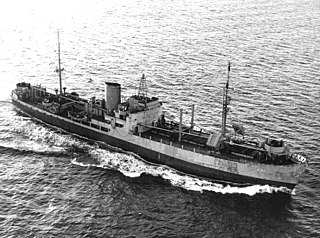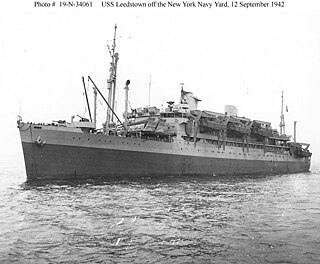
USS Ariel (AF-22) was the United Fruit Company cargo and passenger liner Peten, renamed Jamaica in 1937, that served as a United States Navy Mizar-class stores ship in World War II.
USS Moose (IX-124), an Armadillo-class tanker designated an unclassified miscellaneous vessel, was the second ship of the United States Navy to be named for the moose, a large ruminant animal of the deer family, found in Canada and the northern United States. Originally named Mason L. Weems, she was renamed Moose 27 October 1943. Her keel was laid down on 1 November 1943 by Delta Shipbuilding Company in New Orleans, Louisiana. She was launched on 17 December 1943 sponsored by Mrs. Douglas E. Schultheiss, acquired by the Navy on a bareboat charter from the War Shipping Administration on 27 January 1944, and commissioned on 28 January 1944.

USS Pontiac (AF-20) was the Danish refrigerated cargo ship Australian Reefer that sought refuge in the neutral United States when Germany occupied Denmark in April 1940. In 1941 the United States seized 40 Danish ships idle in its ports with Australian Reefer being among those ships.

USS Mizar (AF-12) was the United Fruit Company fruit, mail and passenger liner Quirigua that served as a United States Navy Mizar-class stores ship in World War II.

USS Uranus (AF-14) was a Uranus-class stores ship bareboat chartered to the U.S. Navy by the War Shipping Administration for use in World War II. The ship was one of the Danish vessels idled in U.S. ports seized by the United States after the occupation of Denmark by German forces. The ship was the Danish J. Lauritzen A/S line vessel Maria, ex Caravelle, ex Helga until chartered to the Navy and commissioned on 11 August 1941 under the name Uranus.

USS Talamanca (AF-15) was the United Fruit Company cargo and passenger liner Talamanca that served as a United States Navy Mizar-class stores ship in World War II.

USS Roamer (AF-19) was the Danish refrigerated motorship African Reefer, completed 1935, of the J. Lauritzen shipping company which had put in at Madeira after Germany occupied Denmark. The ship later sailed to a U.S. port on assurances it would be treated equally with U.S. vessels chartered for war purposes. Instead it was seized by the United States Maritime Commission and placed in service under War Shipping Administration (WSA) allotment to commercial, Army transport and finally Navy use at half the rate paid for U.S. ships. The agreed to rate was not restored until 1958 after a Supreme Court judgement and Congressional action.

USS Merak (AF-21), the second Navy ship of the name, was the United Fruit Company cargo and passenger liner Veragua that served as a United States Navy Mizar-class stores ship in World War II.

USS Taurus (AF-25), formerly SS San Benito, was a refrigerated banana boat of the United Fruit Company that may have been the first merchant ship to be built with turbo-electric transmission. From October 1942 to December 1945 she was a United States Navy stores ship in the Pacific Ocean theatre of World War II. She was scrapped in 1953.
MS Tunis was a Danish motor ship in commercial service for Det Forenede Dampskibs Selskab (DFDS), Copenhagen, Denmark, as a cargo ship delivered to DFDS on 15 January 1936. Tunis was the first of four sister ships, two built in 1936 and two in 1938, that operated for DFDS. The ship's normal service was Copenhagen to the Mediterranean until war in Europe when all four of the ships were put into Atlantic service.

USNS Bald Eagle (T-AF-50) was a Maritime Commission type C2-S-B1 cargo ship delivered to the War Shipping Administration (WSA) in May 1943. The ship was operated by WSA agent shipping companies until July 1948 when laid up in the James River Reserve Fleet briefly before beginning operation for the U.S. Army in October. When the Navy's Military Sea Transportation Service (MSTS) took over all military ocean shipping in 1950 the ship was transferred to operate as one of six refrigerated cargo ships in the MSTS fleet until July 1970 as USNS Bald Eagle. The ship was permanently transferred to Maritime Commission custody in September 1971 and sold for scrap in 1973.

USS Leedstown (AP-73), built as the Grace Line passenger and cargo ocean liner SS Santa Lucia, served as a United States Navy amphibious assault ship in World War II. The ship had first been turned over to the War Shipping Administration (WSA) and operated by Grace Line as the WSA agent from February to August 1942 in the Pacific. In August the ship, at New York, was turned over to the Navy under sub-bareboat charter from WSA. She was sunk 9 November 1942 off the Algerian coast by a German submarine after German bombers caused damage the day before.

USS George F. Elliott (AP-105) was a cargo liner built for the Mississippi Shipping Company as SS Delbrasil for operation between New Orleans and the east coast of South America in 1939 by its operator, Delta Line. The ship entered that service and operated until taken over by the War Shipping Administration (WSA) on 28 April 1942 for operation by Delta Line acting as WSA's agent. On 25 August 1943 WSA allocated the ship to the Navy for conversion to a troop transport commissioned and operated by the Navy for the duration of the war. Ownership of the ship was transferred from Mississippi Shipping to WSA on 4 February 1944 while under Navy operation and was retained until sale to American South African Lines on 22 December 1948. The ship was renamed African Endeavor until returned as a trade in to the Maritime Commission on 22 September 1960 for layup in the James River reserve fleet and later sold to Boston Metals for scrapping.

The Type C4-class ship were the largest cargo ships built by the United States Maritime Commission (MARCOM) during World War II. The design was originally developed for the American-Hawaiian Lines in 1941, but in late 1941 the plans were taken over by the MARCOM.

USS Majaba (AG-43/IX-102) was the Design 1049 cargo ship Meriden built in 1919 by the Albina Engine & Machine Works, Portland, Oregon. All the ships were requisitioned by the United States Shipping Board (USSB) for World War I service. The ship was bought by the E. K. Wood Lumber Co., of San Francisco, California in 1923 and renamed El Capitan. The ship was chartered by the U.S. Navy through the War Shipping Administration (WSA) in April 1942 and commissioned as Majaba.

Banana boat is a descriptive nickname that was given to fast ships, also called banana carriers, engaged in the banana trade. They were designed to transport easily spoiled bananas rapidly from tropical growing areas to North America and Europe. They often carried passengers as well as fruit.

USAHS Acadia was the first United States Army Hospital Ship in World War II. Built in 1932 by Newport News Shipbuilding as a civilian passenger/cargo ocean liner for the Eastern Steamship Lines, the ship was in US coastal and Caribbean service prior to its acquisition by the US Maritime Administration in 1941.

SS Antigua was a United Fruit Company passenger and refrigerated cargo liner completed as one of six nearly identical vessels, three built by Newport News Shipbuilding and three by Bethlehem Shipbuilding Corporation, for operation by the company's subsidiary the United Mail Steamship Company. The ship was the first of the ships built by Bethlehem Shipbuilding Corporation, Quincy, Massachusetts.
SS Haiti was a passenger and freight ship built for the Colombian Mail Steamship Company built at Newport News Shipbuilding, Newport News, Virginia and delivered 15 December 1932. The ship was renamed briefly Puerto Rico in 1938 and Monterey in 1939 to operate for the New York and Cuba Mail Steamship Company until requisitioned with transfer of title to the War Shipping Administration (WSA) on 25 September 1942. The ship was then allocated to the U.S. Army for operation under a bareboat agreement as USAT Monterey. In 1943 the ship was assigned to the command at Trinidad to supply bases in Brazil and Ascension Island. After layup in the reserve fleet the ship was sold to Turkey.

The Type R ship is a United States Maritime Administration (MARAD) designation for World War II refrigerated cargo ship, also called a reefer ship. The R type ship was used in World War II, Korean War, Vietnam War and the Cold War. Type R ships were used to transport perishable commodities which require temperature-controlled transportation, such as fruit, meat, fish, vegetables, dairy products and other foods. The US Maritime Commission ordered 41 new refrigerated ships for the US Navy. Because of the difficulty of building refrigerated ships only two were delivered in 1944, and just 26 were delivered in 1945 and the remainder in 1946–48. The 41 R type ships were built in four groups. Two of design types were modified type C1 ships and two were modified type C2 ships. The United Fruit Company operated many of the R type ships in World War II. The type R2-S-BV1 became the US Navy Alstede-class stores ship and the type R1-M-AV3 became the US Navy Adria-class stores ship.


















